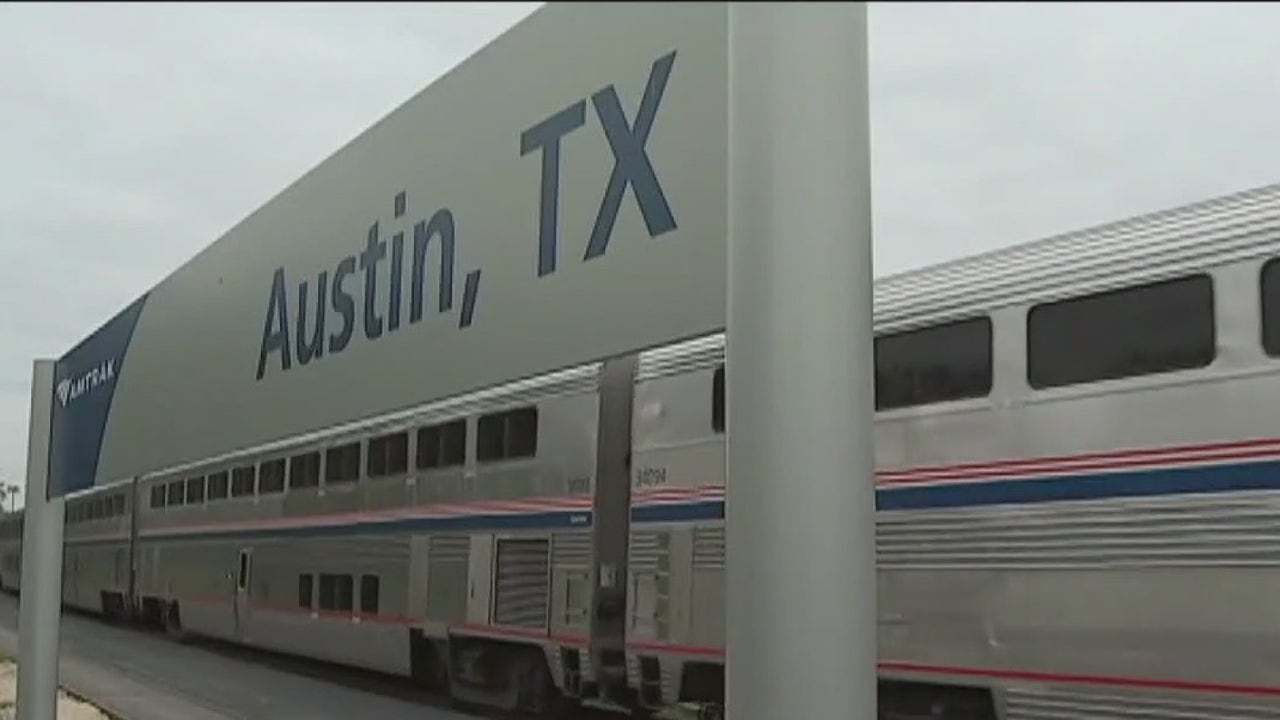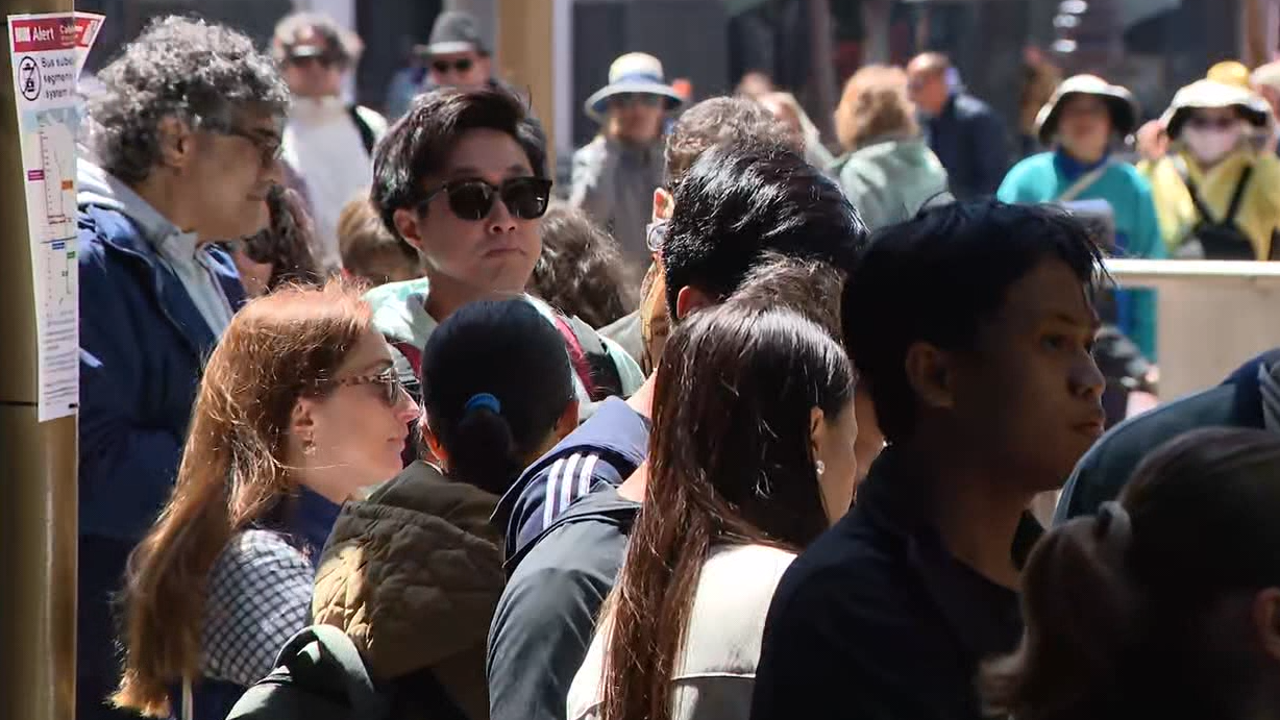Austin, TX
See where Austin ranks among cities in the U.S. with the worst traffic
A new ranking places Austin among the U.S. cities with the worst traffic, though not as high as some might think.
Financial news website 24/7 Wall St. used data from INRIX, a traffic analytics company, to compile a list of the top 32 cities with the worst traffic. The cities were ranked by the average commute time lost to traffic delays in 2022, the change in traffic delays from 2021, the average commute time in each city and the number of commuters who drive or carpool to work:
Austin landed at 19th on the list. Commuters lost 53 hours each waiting in traffic in 2022, and traffic delays in Austin increased by 65% since 2021, according to the data. The average commute time in Austin is around 25 minutes, and the report found just over 400,000 people — or more than 90% of commuters —drive or carpool to work.
More: Hundreds rally against TxDOT’s plans to expand I-35 through Central Austin
Where do other Texas cities fall in the list?
Though Austin’s traffic isn’t ideal, it’s better than a couple cities in Texas. Overall, cities in the state claim four of the top 32 spots on the list.
Houston has the worst traffic in the state and the 11th worst traffic in the country. The average commuter lost 74 hours waiting in traffic in 2022, according to INRIX data, and the average commute in the city is longer than 27 minutes.
Dallas is also ahead of Austin on the list at 14th. Each commuter there lost 56 hours due to traffic in 2022, and the city experienced a 28% increase in traffic delays from 2021.
More: Segments of two new highways open to drivers in eastern Williamson County
San Antonio barely snuck in the top 32 at 28th. Traffic delays caused commuters there to lose 32 hours each in 2022.
How do other cities in the U.S rank?
- Chicago, Ill.
- Boston, Mass.
- New York, NY
- Philadelphia, Pa.
- Miami, Fla.
- San Francisco, Calif.
- Los Angeles, Calif.
- Washington, D.C.
- New Orleans, La.
- Atlanta, Ga.
- Houston, TX
- Stamford, Conn.
- Portland, Ore.
- Dallas, TX
- Baltimore, MD
- Concord, Calif.
- Denver, Co.
- San Diego, Calif.
- Austin, TX
- Seattle, Wash.
- Providence, RI
- Las Vegas, Nev.
- Nashville, Tenn.
- Sacramento, Calif.
- Sarasota-Bradenton, Fla.
- Pittsburgh, Pa.
- Framingham, Mass.
- San Antonio, TX
- Milwaukee, Wis.
- Tampa, Fla.
- Lawrence, Mass.
- Hartford, Conn.
Texas cities also among worst places to drive
A separate report from 24/7 Wall St. in April named three Texas cities as some of the worst places to drive in the U.S. The list looked at the average traffic delays per commuter in 2020, the number of deadly crashes per 100,000 people from 2011-2020, the share of deadly crashes caused by weather or road design/conditions and the share of driving deaths involving alcohol.
More: One dead in accident on Texas 71 headed to Austin airport; traffic being diverted to US 183
The greater Austin area placed 21st on that list, well behind Odessa at 10th and the greater Houston area at fourth.

Austin, TX
Texas lawmakers could help push forward plans for high-speed rail

AUSTIN, Texas – State lawmakers could help push forward plans to build a high-speed rail connecting San Antonio, Austin, and Dallas.
On April 28, a House Transportation Committee heard testimony on HB 483. The bill would allow TxDOT to reach agreements with a private company to build, maintain, and operate a high-speed rail along the I-35 corridor.
The intercity passenger rail would be expected to reach speeds of at least 110 mph.
Lawmakers said it’s needed to build a modern transportation network that meets the urgent need of our growing population.
“We’re behind Florida in high speed rail. Orlando, Florida, has done amazing things, leapfrogging over the state of Texas and the rest of the nation with regard to high-speed rail, with great advantage to Florida residents. Texas talks about being number one. We need to be number one,” said Sen. Sarah Eckhardt.
The legislation would also repeal a 2017 ban on state investments in high-speed rail.
It still needs passage in both chambers to become law.
Austin, TX
Best Fun Events In Austin This Weekend Of May 2, 2025

Things to Do in Austin This Weekend of May 2, 2025
Our top picks for the Best Fun Events in Austin this Weekend of May 2
Check out the full list below!
Editor’s Note: Our staff works hard to bring you the latest information. However, all information mentioned in this article is subject to change. As always, please confirm before heading out.
Free Things To Do Austin this Weekend
Spring Pecan Street Festival


Image credit: Pecan Street Festival
Get ready for the Pecan Street Festival, a free, two-day arts extravaganza where hundreds of incredible artisans, both local and national, will showcase their unique, handcrafted wonders.
Aside from enjoying the art, you can groove to nearly 50 of Austin’s best musical acts across three stages and savor tempting treats from thirty diverse food vendors.
The little ones can also dive into a world of kid-friendly fun with rides, a petting zoo, and interactive workshops.
Where: Hill Country Galleria, 12700 Hill Country Blvd, Bee Cave, TX 78738
When: Saturday, May 3 – 4, 2025
How Much: Free
CelebrASIA Austin
CelebrASIA Austin will be delivering a wealth of cultural experiences for the whole family, marking 11 years of community and culture at the AARC.
So prepare to immerse yourself in captivating performances, savor delicious offerings from food vendors, and explore engaging exhibits from various cultures all across Asia.
Where: Asian American Resource Center, 8401 Cameron Rd, Austin, TX 78754
When: Saturday, May 3, 2025 | 11 am – 3 pm
How Much: Free
La Fete de Cindo de Mayo


Image credit: mexic-artmuseum
Get ready for La Fête de Cinco de Mayo, a dazzling family event where the vibrant traditions of Mexico and France unite. Dive into a day brimming with engaging activities, playful educational games, and captivating performances that will spark joy and discovery for everyone.
Where: Republic Square, 422 Guadalupe St, Austin, TX 78701
When: Saturday, May 3, 2025 | 9 am – 1 pm
How Much: Free
The Front Market
Prepare to discover unique finds and support local artistry all weekend long at the Front Market! There will be over 150 independent creatives, artists, designers, and small business owners from across Texas South showcasing their crafts.
Where: Rollins Theatre at the Long Center for the Perfroming Arts, 701 W Riverside Dr, Austin, TX 78704
When: Saturday, May 3 – 4, 2025 | 11 am – 5 pm
How Much: Free
Violet Crown Festival
Get ready for a weekend bursting with flavor, rhythm, and handcrafted treasures at the Violet Crown Festival.
But that’s not all! Prepare for a BBQ showdown as teams from across the city fire up their smokers in a fierce cook-off, vying for the title of BBQ champion. There will also be live music headlined this year by the iconic Dale Watson and His Lone Stars.
Where: Brentwood Neighborhood Park, 6710 Arroyo Seco, Austin, TX 78757
When: Saturday, May 3, 2025 | 10 am – 5 pm
How Much: Free
Things To Do in Austin this Weekend – Friday Events
Annie
Join Annie in a celebration of family, unwavering optimism, and the enduring American spirit in a heartwarming musical that will give you a nice dose of sunshine.
The play is directed by Jenn Thompson, with the unforgettable songs by Tony Award winners Thomas Meehan, Charles Strouse, and Martin Charnin.
Where: Bass Concert Hall, 2350 Robert Dedman Dr, Austin, TX 78712
When: Friday, May 2 – 4, 2025
How Much: Starts at $30
Silent Disco
This weekend, ditch the usual and dive into Quiet Clubbing at The Belmont. You get to choose your soundtrack for the night as three live DJs spin different genres, all while you dance the night away with your glowing LED headphones.
Where: The Belmont, 305 W 6th St, Austin, TX 78701
When: Friday, May 2, 2025 | 10 pm – 2 am
How Much: $10 – $20
Spring Carnival 2025
Get ready for a weekend explosion of fun in Austin! Prepare to spin on thrilling rides, test your luck at classic carnival games for awesome prizes, and indulge in all your favorite carnival treats just outside the arcade doors.
But the excitement doesn’t stop there! Inside, you’ll discover a colossal arcade packed with both the latest hits and beloved retro games. And when you need to refuel, Pinballz Lake Creek offers a full scratch kitchen and two bars serving up delicious food and drinks.
Where: Pinballs Lake Creek, 13729 Research Blvd, Austin, TX 78750
When: Friday, May 2 – 11, 2025 | 5 pm – 11 pm
How Much: Free entry | Rides and games require tickets
Blue Genie Art Bazaar May Market


Image credit: Blue Genie Art Bazaar
Dive into the fifth annual May Market and prepare to discover a vibrant collection of unique creations, showcasing the talents of nearly 200 regional artists and artisans.
Where: Blue Genie Art Bazaar, 6100 Airport Blvd Ste C, Austin, TX 78752
When: Friday, May 2 – June 1, 2025 | 10 am
How Much: Free entry
Texas Burlesque Festival
Houston, prepare for a weekend spectacle of dazzling proportions! The reigning Queen of Tease from New Orleans, Jeez Loueez, alongside Chicago’s Kings of Boylesque, Bazuka Joe and Ray Gunn, and the legendary Lovey Goldmine from Las Vegas, are converging for an unforgettable burlesque extravaganza.
Get ready to cheer, applaud, and encourage these incredible performers as they present tantalizing acts, from classic peels to hilarious spins on pop culture.
Where: Blue Genie Art Bazaar, 6100 Airport Blvd Ste C, Austin, TX 78752
When: Friday – Sunday, May 2 – 4, 2025 | 8 pm – 1:30 am
How Much: Starts at $25
Things to Do in Austin this Weekend – Saturday Events
Austin FC vs Minnesota United FC
Looking for the perfect Austin weekend thrill? Immerse yourself in the heart-pounding action of live soccer. Be part of the roaring atmosphere as you support Austin FC against Minnesota United.
Where: Q2 Stadium, 10414 Mc Kalla Pl, Austin, TX 78758
When: Saturday, May 3, 2025 | 7:30 pm
How Much: Starts at $73
Cinco de Mayo Run: Against All Odds
Join the Run Against All Odds and ignite your Cinco de Mayo spirit alongside a vibrant community. Challenge your limits, embrace resilience, and honor the rich culture of Cinco de Mayo!
Where: Richard Moya Park, 10001 Burleson Rd, Austin, TX 78719
When: Saturday, May 3, 2025 | 7:30 am – 10:30 am
How Much: $39
Kentucky Derby Party
Catch every heart-pounding second of “the most exciting two minutes in sports” on multiple screens at Live Oak’s Kentucky Derby Party! Your admission includes a complimentary mint julep and a race chit to predict the top three finishers.
You can also join the contests for best hat and best dressed, so get ready to don your favorite derby attire.
Where: Live Oak, 98 San Jacinto Blvd, Austin, TX 78701
When: Saturday, May 3, 2025 | 4 pm – 7 pm
How Much: $70
Margarita and Salsa Mini Festival
This weekend, Beachside Billy’s is throwing a Margarita and Salsa Tasting Mini Festival that’s sure to ignite your taste buds. For just $45, you’ll get to savor six unique 6 oz margaritas perfectly paired with six distinct and zesty salsas.
But the fun doesn’t stop there! Your ticket also unlocks all-day access to the waterpark, complete with a free parking pass. As the sun sets, the party will keep going with a Late Night Pool Party featuring DJ PAPI RICO!
Where: Volante Beach Water Park, 16107 Farm to Market Rd 2769 Suite D, Leander, TX 78641
When: Saturday, May 3, 2025 | 12 pm – 4 pm
How Much: $45
Synesthesia: An Immersive Audiovisual Dance Party
The boundaries between a party and a performance will vanish this weekend at Synesthesia. Dynamic DJ sets will pulse through the venue, while captivating projection art dances across the walls.
Added to that, there will also be breathtaking aerial dancers and live painters adding layers to this sensory symphony, creating a fully immersive and awe-inspiring experience.
Where: Propaganda HQ, 625 Industrial Blvd, Austin, TX 78745
When: Saturday, May 3, 2025 | 10 pm – 4 am
How Much: $15 Early Bird | $20 Presale | $25 at Door
iHeart Country Festival


Image credit: iHeartCountry
The iHeartCountry Festival is here. Watch out for performances from the legendary Brooks & Dunn, the chart-topping Thomas Rhett, and the unforgettable Rascal Flatts.
There will also be performances from Sam Hunt, the rising star Megan Moroney, the powerful Bailey Zimmerman, and the captivating Nate Smith.
Where: Moody Center, 2001 Robert Dedman Dr, Austin, TX 78712
When: Saturday, May 3, 2025 | 7 pm
How Much: Starts at $56
Mayday Parade in Concert
Houston, get ready for a sonic blast this weekend! Mayday Parade is hitting Austin in celebration of their fresh album, Sweet, and you won’t want to miss it.
Where: Austin City Limits Live (ACL Live), 310 W Willie Nelson Blvd, Austin, TX 78701
When: Saturday, May 3, 2025 | 7 pm
How Much: Starts at $40
Things to Do in Austin this Weekend – Sunday Events
2025 H-E-B Austin Sunshine Run


Image credit: Austin Sunshine Run
Bring your A-game for a good cause at the Austin Sunshine Run! Lace up your running shoes for the 5K, challenge yourself with the 10K, let the little ones zoom in the Kids K, or even cheer on the Fastest Dog in Austin 5K!
Celebrate your achievement afterwards with food, drinks, and music, all while supporting life-changing experiences for historically underinvested youth in Central Texas through the Austin Sunshine Camps.
Where: Auditorium Shores, 900 W Riverside Dr, Austin, TX 78704
When: Sunday, May 4, 2025 | 8 am – 10 am
How Much: $40
Jack White in Concert
The legendary Jack White is heading to Austin, bringing the raw energy of his new EP, “No Name.” Prepare for a night of electrifying riffs and powerful vocals that will shake the stage.
Where: Austin City Limits Live (ACL Live), 310 W Willie Nelson Blvd, Austin, TX 78701
When: Sunday, May 4 – 5, 2025 | 8 pm
How Much: Not stated
To get these updates delivered directly to your feed, give us a follow on Facebook by clicking the …next to the search lens icon.
Travel on your mind? Check out Free and Cheap Events in Houston this Weekend and Best Fun Events in Austin this Weekend.
Austin, TX
Texas’ mortality crisis isn’t random. These deaths reflect policy failures | Letters

Re: April 21 article, “People aren’t living as long as they did 4 years ago, data shows”
Your recent article on declining life expectancy in Texas points to a deeper crisis. As a public health researcher studying “deaths of despair” — from suicide, alcohol and drug overdoses — I’ve found these deaths have increased by 153% in Texas since 2000, especially among those of working-age in economically distressed counties.
In 2020 alone, the state lost nearly 372,000 years of potential life to preventable causes. These outcomes aren’t random. They reflect policy choices. Texas still refuses to expand Medicaid, ranks near the bottom in mental health funding, and has passed abortion bans contributing to a 56% rise in maternal mortality from 2019 to 2022.
We know what works: Access to care, housing and economic opportunity saves lives. What’s missing is the political will to act.
Camerino I. Salazar, doctoral candidate, University of Texas at San Antonio
When will we heed the urgent warnings on climate change?
Re: April 24 article, “Climate ‘tipping points’ are near”
When there is virtually unanimous consensus among the people who devote their entire careers to studying a given topic, who are the world’s foremost experts, we had best pay attention to what they say — especially when what they say is irrefutably backed up by evidence every one of us can see in our daily lives.
To date, we have not paid much attention to what the experts are saying about how we are disrupting, even destroying, Mother Nature’s harmony. American Indians and many other indigenous groups around the world lived without pillaging and destroying the environment that sustains us, but our society has not found a way to do so. We continue to ignore the warning signs screaming all around us — at our own peril.
Technological advances are not going to get us out of this mess. We must make social, political, economic, behavioral and attitudinal changes.
Mark Warren, Austin
State duplicates the agency focused on efficiency
Re: April 24 article, “Abbott signs DOGE bill, targets state bureaucracy”
So, by a fell swoop of pen and cooperation of the highly efficient Legislature, Gov. Greg Abbott has created the Texas Department of Government Efficiency (DOGE). Interesting, because I always thought that was the function of the Texas Sunset Commission. For some reason, it does not seem efficient to have two agencies performing the same task.
But what do I know. I’m just a tax-paying citizen.
John Williams, Austin
Texas DOGE can start by killing anti-renewables bill
Gov. Greg Abbott has signed a bill to establish a state agency to find and remove regulations that hamper Texas’ growth. Let’s start by killing the bill designed to hinder growth of renewable energy. About 30% of energy generated in Texas is from solar and wind — and it is cheaper than electricity from coal or natural gas.
Wealthy Republican donors are sitting on a reservoir of natural gas in west Texas that is threatened by the renewable sector, which is really what Senate Bill 819 is about. Kill it now.
Lawrence Ragan, Austin
Great. The bathroom police are back.
Re: April 22 article, “Texas Senate to hear bathroom bill”
So, will the state hire cops to check peoples’ privates before they enter a public restroom? I’m a 78-year-old woman who enters a restroom, hoping there is toilet paper in the stall before I lock the door. Who cares if the person in the next stall is gay, straight or trans? Do your business and wash your hands. Hopefully there are towels or a hand blower!
Aren’t there more important things to worry about?
Haven’t we moved on from the “whites only” days of discrimination? Things aren’t looking “great” if we continue down this path. Perhaps tattoos will be next, so we can quickly identify and judge one another.
Sue Kemp, Austin
Bills give Pornhub a pass without solving the problem
Texas legislators are considering Senate Bill 2420 and HB 4901. Both would implement app store verification mandates. While intended as an alternative to requiring age verification at the site level, this serves to help app developers dodge accountability for keeping children safe without solving the problem.
Worse, the bills mandate that app stores share user age information with every app developer regardless of the app’s nature or user consent, which creates severe privacy hazards for all users of the platform, regardless of whether they are trying to access apps with adult content.
The bills do nothing to address the many other ways children can access online platforms and sites with adult content. They only serve to exempt sites like Pornhub — which is supporting SB 2420 — from the responsibility of protecting children from the online harms on its platform.
Our legislators in Austin should scrap both bills.
Bill Peacock, Dripping Springs
An apt reminder of Austin Animal Center’s no-kill ethos
Re: April 20 commentary, “Austin can again become leader in animal services,” by Tawny Hammond
Thank you, Tawny Hammond, for reminding us of how Austin was once a no-kill leader. Our city animal shelter has recently failed to serve our community by refusing to even take in found animals. Now we have a chance to help people keep their pets through supportive programs and improve shelter life for the animals by making it easier to volunteer, foster and adopt.
I hope that City Manager T.C. Broadnax will show us that he wants to embrace what Austin is all about and find a new shelter director with the vision that Tawny Hammond brought during her too-short tenure.
Rona Distenfeld, Austin
Waiting for that voters’ remorse to kick in
Re: April 23 article, “Poll shows further dip in Trump’s approval rating”
How many more things need to go sideways before the folks who voted for President Trump finally admit they made a grievous error in judgment? I thought things were supposed to get better? He never said there would be a “period of adjustment.” He said it would be “immediate!”
Wake up and smell the coffee before that tariff hits the smell.
Tip Giles, Austin
Look at the damage done in just in a few months
I want to thank you all who voted for President Trump for all that is happening in this country.
I once was a Republican and believed that this was a country that always did the right thing. Now elected officials are working steadfastly to whitewash American history. DEI is a dirty word.
The Trump administration is attacking the freedom of speech and discussion in our universities. They are silencing scientific research in our health care system. They are invading our private lives and destroying our right to privacy. They are arresting people who have broken no laws. They have gotten rid of due process. They have destroyed America’s reputation so that no country will ever trust us to do what we promised to do.
Wealth has power. If only it was used for good.
Richard Chiarello, Austin
How to submit a letter to the editor
Send letters of no more than 150 words by using our online form at https://bit.ly/3Crmkcf or send an email to letters@statesman.com.
We welcome your letters on all topics. Include your name and city of residence; we do not publish anonymous letters.
-
News1 week ago
Harvard would be smart to follow Hillsdale’s playbook. Trump should avoid Biden’s. | Opinion
-

 Politics7 days ago
Politics7 days agoVideo: Hegseth Attacks the Media Amid New Signal Controversy
-

 Culture5 days ago
Culture5 days agoNew Poetry Books That Lean Into Calm and Joy Amid Life’s Chaos
-

 News1 week ago
News1 week agoMaps: Where Do Federal Employees Work in America?
-

 Technology1 week ago
Technology1 week agoPete Hegseth reportedly spilled Yemen attack details in another Signal chat
-

 Politics1 week ago
Politics1 week agoPope Francis and US presidents: A look back at his legacy with the nation's leaders
-

 World7 days ago
World7 days agoNew Zealand’s minor gov’t party pushes to define women by biological sex
-

 Politics1 week ago
Politics1 week agoJD Vance has ‘exchange of opinions’ on issues like deportations during meeting with top Vatican official

















